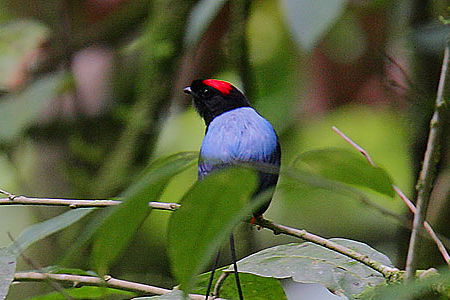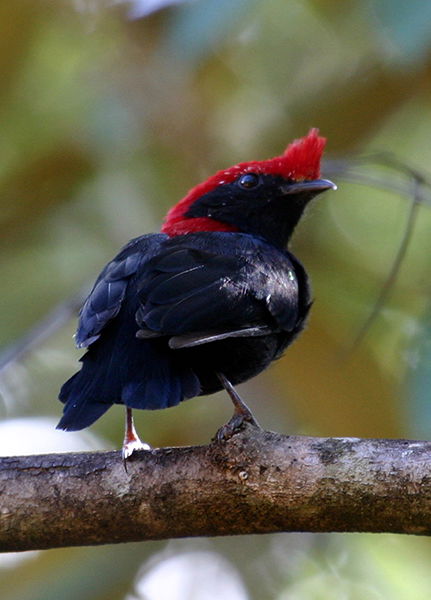No Dummy
Zieger M, CC BY-SA 4.0 via Wikimedia Commons
Pipridae
by Inspector Barry Mins on January 31, 2023Hey kids, welcome back to our series on the mysteries of created kinds. Last week, we met a desert toad kind. This week, we’re moving from the heat of the desert to the humidity of the tropics, looking for a colorful kind of bird.

The members of this kind are largely frugivores, meaning their preferred foods are fruits and fruit seeds.1 Some species are very good dispersers of seeds.2 Although they prefer fruit as food, they will, however, sometimes capture individual ants and rub them against their feathers to maintain feather quality.3 Despite their bright colors, they do not use melanosomes to create color. Instead, they use keratin, the same material in your fingernails, and packets of air trapped in their feathers to reflect light in a wide variety of colorful ways.4 Males in some species will go through five sets of plumage before reaching their colorful mature form.5
Members of this kind often breed in what is called a lek. A lek is an area where multiple males assemble and compete for the attention of females. Most of this kind are sexually dimorphic, which means it is usually easy to tell males from females. However, at least in one species, sexual dimorphism is minimal and leks are not used.6 In some leks, a dominant male will work with subordinate males to court females, but only the dominant male will breed.7 In others, the males will defend their lek against all comers and attempt to win the attention of the females.8 Brighter plumage tends to help males win the contest.9
The nests of this kind are usually cuplike in shape.10 They are often built in forks in tree branches a mere few feet off the ground.11 Nests are made of dried plants, spider webbing, leaves, and lichens.12
Has anyone figured it out yet? This week’s kind is the Pipridae—the manakin kind. Stay tuned for next week when we start looking for a genus of western North American newts.
Try out this fun word search!
Clue
Your clue for the week is:
These amphibians are highly toxic and mark their toxicity with colorful warnings.
Ask a Question
Have you ever had a question about created kinds but didn’t know who to ask? Have you ever wanted to learn more about your favorite kind? Well, now you can! You can ask me, Inspector Barry Mins, a question! Have your parents help you fill out this form, and you might get your question answered in my column! If you have any questions about created kinds, feel free to send them my way!
Footnotes
- A. M. Silva and C. de Melo, “Frugivory and seed dispersal by the helmeted manakin (Antilophia galeata) in forests of Brazilian Cerrado,” Ornitologia Neotropical 22, no. 1 (2011): 69–77.
- M. Santos, L. Alencar, and E. Guilherme, “Black Manakin (Xenopipo atronitens) as a keystone species for seed dispersal in a white-sand vegetation enclave in Southwest Amazonia,” Community Ecology 23 (2022): 55–62.
- C. Cestari, “Anting behavior by the White-bearded Manakin (Manacus manacus, Pipridae): an example of functional interaction in a frugivorous lekking bird.” Biota Neotropical 10, no. 4 (2010): 339–342.
- B. Igic, L. D’Alba, and M. D. Shawkey, “Manakins can produce iridescent and bright feather colours without melanosomes,” Journal of Experimental Biology 219, no. 12 (2016): 1851–1859.
- S. M. Doucet, D. B. McDonald, M. S. Foster, and R. P. Clay, “Plumage development and molt in long-tailed manakins (Chiroxiphia linearis): variation according to sex and age,” The Auk 124, no. 1 (2007): 29–43.
- R. D. Ribeiro, J. E. McCormack, H. G. Álvarez, L. Carrasco, G. F. Grether, P. Mena-Olmedo, R. Sedano, T. B Smith, and J. Karubian, “Loss of sexual dimorphism is associated with loss of lekking behavior in the green manakin Xenopipo holochora,” Journal of Avian Biology 46, no. 3 (2015): 307–314.
- M. B. Robbins, “Social Organization of the Band-Tailed Manakin (Pipra fasciicauda),” The Condor 87, no. 4 (1985): 449–456.
- R. O. Prum, J. D. Kaplan, and J. E. Pierson, “Display Behavior and Natural History of the Yellow-Crowned Manakin (Heterocercus flavivertex: Pipridae),” The Condor 98 (1996): 722–735.
- A. C. Stein, and J. A. C. Uy, “Plumage brightness predicts male mating success in the lekking golden-collared manakin, Manacus vitellinus,” Behavioral Ecology 17, no. 1 (2006): 41–47.
- J. C. Salazar and G. A. Londoño, “Nesting biology of the golden-winged manakin (Masius chrysopterus), with a review of nesting traits for lowland and highland species of Pipridae” Ornitologia Neotropical 33, no. 1 (2022): 58–65.
- J. Hazlehurst and G. A. Londoño, “Reproductive biology of the Yungas Manakin (Chiroxiphia boliviana) in Manu National Park, Peru,” Ornitologia Neotropical 23, no. 4 (2012): 597–601.
- K. V. Linhares, F. A. Soares, and I. C. S. Machado, “Nest support plants of the Araripe Manakin Antilophia bokermanni, a Critically Endangered endemic bird from Ceará, Brazil,” Contiga 32 (2010): 121–125.
- © 2024 Answers in Genesis
- Privacy Policy
- Contact
- About



